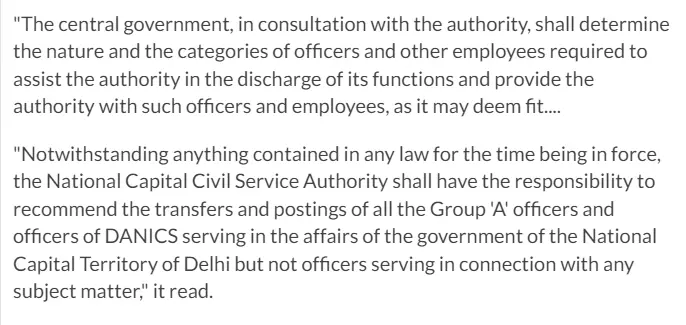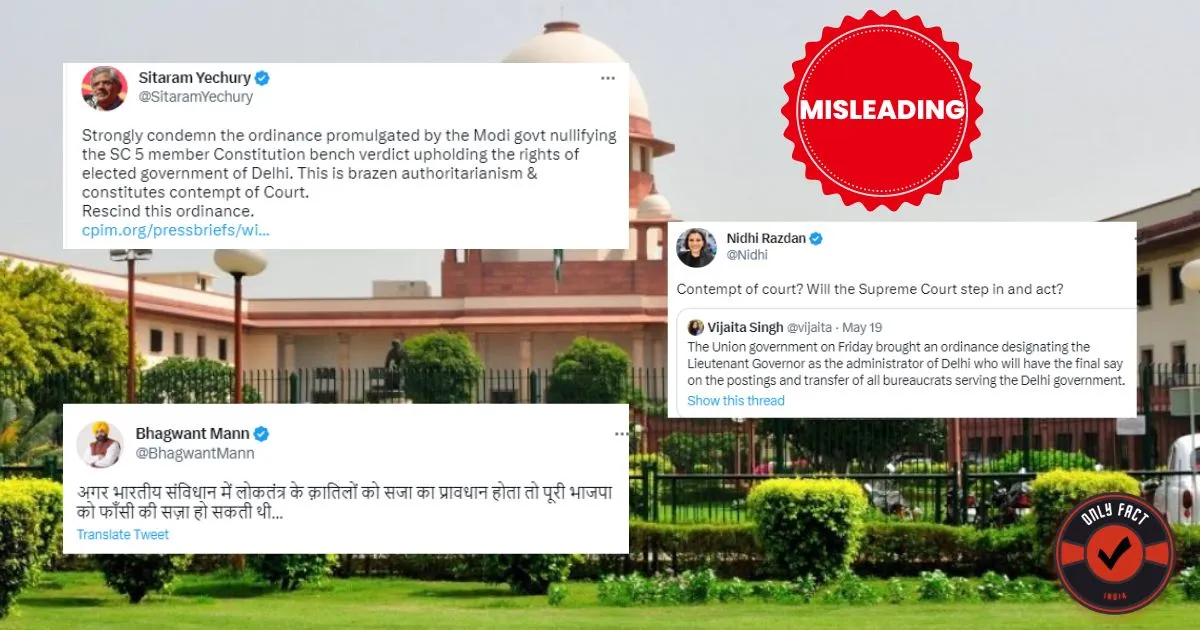On May 19, the Indian government dealt a significant blow to Delhi Chief Minister Arvind Kejriwal by issuing an ordinance aimed at overturning the Supreme Court’s ruling that granted control of ‘services’ to the Delhi government. However, just a few days earlier, the Supreme Court provided some relief to the Delhi government by ordering, that bureaucrats working with the government, excluding those involved in police, public order, and land matters, should be under the authority of the elected government.
According to the Hindustan Times, ‘The ordinance stated that the central government, in consultation with the authority, will determine the types of officers and employees needed to assist the authority in its functions. The authority will be provided with suitable officers and employees.
The National Capital Civil Service Authority, regardless of any existing law, will be responsible for recommending transfers and postings of all Group ‘A’ officers and DANICS officers serving in the affairs of the government of the National Capital Territory of Delhi. However, this responsibility does not extend to officers serving in connection with specific subject matters.’

Be that as it may, Twitter users started reacting to this decree. Like always, there are two sides to an aisle, evincing the varieties of human nature.
Furthermore, many Twitter users started calling out the ordinance – unconstitutional and in contempt of court.
Nidhi Razdan, a senior journalist, tweeted, “Contempt of court? Will the Supreme Court step in and act?”
Madhavan Narayanan tweeted, ‘Attempt by BJP to supersede SC ruling on Delhi govt by constituting an authority through a loophole. Wonder if AAP will take this as contempt of court.’
Raghav Chaddha, a Rajya Sabha member from the Aam Aadmi Party, tweeted in the same vein.
Bhagwant Mann, the chief minister of Punjab, commented, “If there was a provision of punishment for the killers of democracy in the Indian Constitution, then the entire BJP could have been hanged.”
Now the question before us is by bringing the new ordinance into effect, is the Modi government really smothering the constitution of India? Is it unconstitutional to use the ordinance to negate the court rulings? or is it contempt of court?
We will find out below.
Also Read: Kaushik Basu claim debunked: No, India has not lost to Bangladesh in per capita Income
Fact Check
We began our research by looking for the recent Supreme Court order that precipitated this whole saga. However, we found the recent 105 pages order of Case No. 2357 of 2017. Government of NCT of Delhi versus Union of India.
After thoroughly going through the order, we found that on page number 66, Part I and the 95th paragraph of the order, the Supreme Court of India has explicitly mentioned the room of parliamentary procedure. In other words, intervention by the Central Government. The order says, “However if Parliament enacts a law granting executive power on any subject which is within the domain of NCTD, the executive power of the Lieutenant Governor shall be modified to the extent, as provided in that law.”

Upon careful examination from a legal perspective, it becomes evident that the Delhi Government is strategically employing the provisions of Article 239AA of the Indian Constitution.
According to ANI, “Article 239AA provides the framework for the exercise of legislative powers by the legislative assembly of the Union territory of Delhi and the Parliament in respect of Delhi. Entry 41 of the List- II (State List) authorises a state government to frame laws on state public services and the state public service commission.”

According to the Indian Express, ‘The court clarified that the LG does not have independent decision-making power. He must either act on the ‘aid and advice’ of the Council of Ministers or follow their decisions. The LG should not mechanically implement decisions without proper consideration and should not refer every decision of the Council of Ministers to the President.’

However, to override the provisions mentioned in Article 239AA, there is Article 239AB.
According to the constitution of India, “If the President, on receipt of a report from the Lieutenant Governor or otherwise, is satisfied—
(a)that a situation has arisen in which the administration of the National Capital Territory cannot be carried on in accordance with the provisions of article 239AA or of any law made in pursuance of that article; or
(b)that for the proper administration of the National Capital Territory it is necessary or expedient so to do,
the President may by order suspend the operation of any provision of article 239AA or of all or any of the provisions of any law made in pursuance of that article for such period and subject to such conditions as may be specified in such law and make such incidental and consequential provisions as may appear to him to be necessary or expedient for administering the National Capital Territory in accordance with the provisions of article 239 and article 239AA.”

Therefore, now we have proved two things.
1- The Supreme Court, in its recent ruling in NCT of Delhi vs. Union of India, has provided a space for the government of India to manoeuvre the ruling through parliamentary proceedings. Thus, the ordinance is not contempt of court.
2- With respect to Article 239AA, which is also a main weapon in the Delhi Government’s legal inventory, the Constitution of India gives a counterattack move to the government of India, called Article 239AB.
Now, the next question before us is whether the open defiance by the government of India is unprecedented.
No, many times in the past, the government of India, irrespective of political alignments, has brought ordinances on multiple occasions that have nullified court rulings.
Examples of Parliament overruling court’s judgements.
A leading example is one of the most ignominious cases in the history of Indian ethics. In the case of Shah Bano Begum, the SC ruled that a Muslim wife had the right to receive alimony. Despite that, the Legislature passed the Muslim Women (Protection of Rights on Divorce) Act, of 1986. This act took away the right to alimony for Muslim women.

In a similar fashion, In 2018, the Supreme Court recognized that the SC/ST Atrocities Act was being misused. SC emphasized the importance of balancing social goals with individual rights and clear guidelines for filing complaints and making arrests. However, this decision faced widespread criticism, leading to an amendment of the SC/ST Act. Moreover, this act essentially negated the precautionary measures and protective directions issued by the Supreme Court to prevent misuse of the Act.

In conclusion, we have umpteen legal cases to say that the ordinance brought by the government of India on May 11 is not unprecedented. Parliament is entitled to override the Supreme Court rulings. Moreover, in this case, there are two technicalities, that the central government has used tactically in their favour. Ergo, the ordinance is within the ambit of the law.
As former attorney general, K.K Venugopal famously said, “Courts can pass any number of judgments. The Parliament can always say that we will not accept it because it is not in the interest of the people. Parliament is entitled to override the judgment of the Supreme Court, within the contours of what is permitted.”
| Claim | By bringing an ordinance, PM Modi is murdering democracy. The ordinance is contempt of court and unconstitutional. |
| Claimed by | Journalists and Aam Aadmi Party |
| Fact Check | Misleading |
The goal of the Only Fact Team is to provide authentic news facts and debunk lies to safeguard readers’ interests.
Dear Readers, we are working to debunk fake news which is against India. We don’t have corporate funding like others. Your small support will help us grow further.
If you like our work, support and donate us using the Livix Media Foundation QR code.
Jai Hind!








